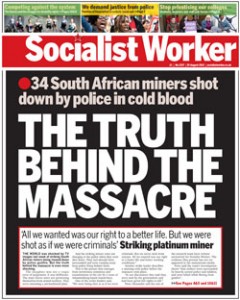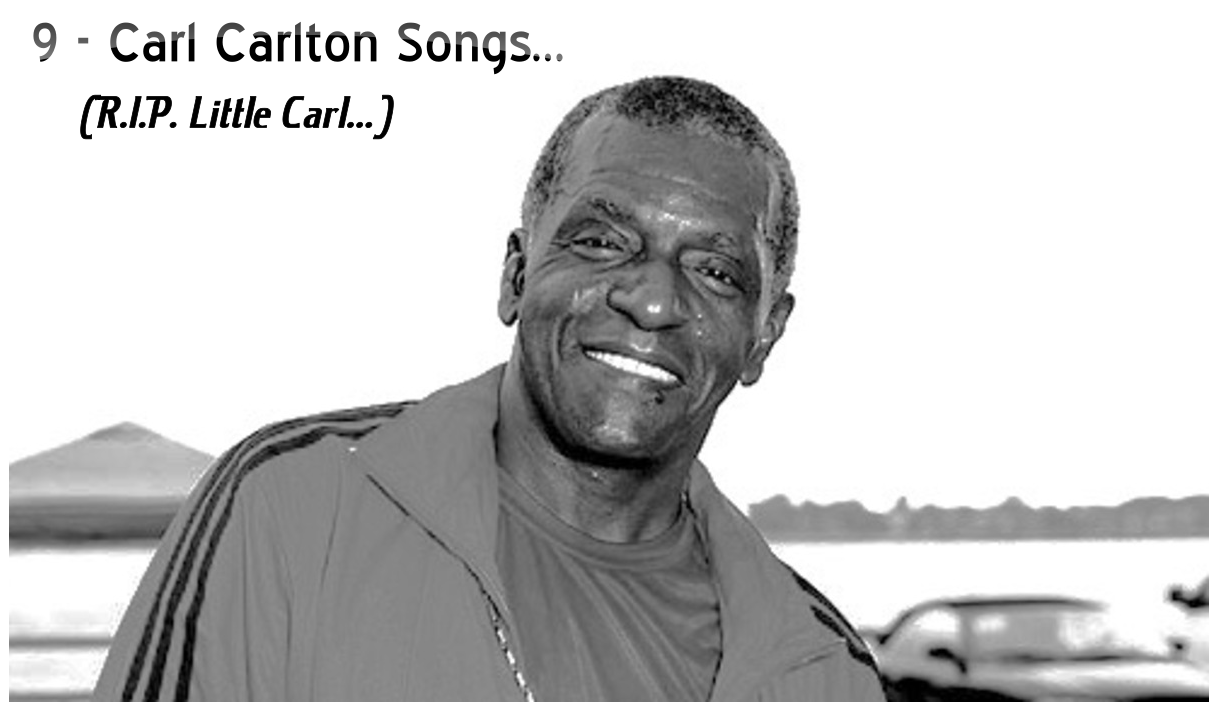(ThyBlackMan.com) The 24 hour news cycle is too rapid to adequately process everything on offer. Arguably the most significant single event connected to my work in southern Africa as a representative of the largest trade union federation in the United States occurred just a few days after my transfer from the sub-region. The Lonmin platinum mineworkers strike and the violence connected with it revealed much about labor-management relations, policing, economic inequality, and the nature of protest in South Africa. Now that the strike has ended, South Africans are left to reflect on the larger issues. Those eclipse the concluded industrial action.
It was a little over a month ago when it happened. On that night, I was losing a battle against sleep in my hotel room in Abuja, Nigeria. I glanced up at the television and saw what appeared to be a scene from a movie. The volume was low. Had I mistakenly switched the channel from Al Jazeera?
The clothing worn by the men featuring on screen was unmistakable. This was the South African Police Service (SAPS). I knew them well. I had worked with the largest of the trade unions representing the SAPS on regional labor programs throughout southern Africa. I had been assigned as my employer’s representative there for five years. I had also worked in a limited capacity with the larger of the two Lonmin mining unions.
The Al Jazeera correspondent was saying something about violence being a language in South Africa. Wasn’t violence a language widely spoken globally? South Africa surely couldn’t be any different. The SAPS personnel carrier was advancing. Teargas canisters were launched. This was followed by automatic weapons fired by the police directly into the crowd of protestors. Video cameras were rolling throughout.
[youtube lLvA4njfPRk]
This was not the shaky cell phone camera work I was accustomed to seeing in civilian reports transmitted from various global hotspots. This was the work of a professional. It struck me as peculiar that the police felt no shame or fear in allowing the filming of a massacre. Could they have possibly thought that a direct, lethal engagement with no warning shots and no attempt at crowd control was responsible policing? Maybe I had missed something.
As the smoke cleared, the result of the police assault became apparent. The dead, dying, and injured miners of Lonmin in Marikana, North West Province were left lying on the ground. Those that survived were writhing in agony from their injuries. The filming continued. The short video clip seemed closer to the longest narrative film in history, Berlin Alexanderplatz, in duration. Too much was happening in what was a very short space of time. Al Jazeera was repeating the footage every 10 minutes it seemed. The other news outlets were following suit.
from their injuries. The filming continued. The short video clip seemed closer to the longest narrative film in history, Berlin Alexanderplatz, in duration. Too much was happening in what was a very short space of time. Al Jazeera was repeating the footage every 10 minutes it seemed. The other news outlets were following suit.
I found a video clip of the shooting on YouTube and posted it to my Facebook page. I played it continuously and had discussions about it with friends via Skype. The reaction to the footage was similar. Was this real? If it was real, why would the police allow it to be filmed?
A black majority government did not eliminate state sponsored violence in South Africa. While on assignment there I learned that supposedly non-lethal crowd control measures could prove fatal if improperly used. The two rubber bullets fired directly into the chest of South African activist Andries Tatane in 2011 was proof positive of that. The beating and subsequent murder of Mr. Tatane was also filmed and broadcast widely.
[youtube vB5uu7QPvoY]
A few years before that, I personally witnessed people being shot at point blank range with rubber bullets during the period of the xenophobic attacks in Johannesburg. Unlike Lonmin, those being shot were not protestors at all. They were just unlucky enough to have been walking past a police crackdown in the city.
The Lonmin mineworkers strike exposed a number of complex issues. It required an address of worker power or the lack thereof. It demanded that post-apartheid South African realities of race and class be navigated before the particulars of the strike itself were even engaged. Independence movements are often awash in blood. The aftermath is seldom different.
The unpacking of economic reality in what remains one of the most unequal nations on earth is something that can’t be adequately addressed in a short essay. Let’s rather focus on the video footage and the reaction to it.
For some of my associates in America, the clip was watched no differently than an action film connoisseur might view the Brazilian film Elite Squad or its sequel. The thought may have crossed a few minds that overwhelming and deadly force being used in a foreign country to control an unruly and violent population could be justified. Perhaps for some viewers, greater attention was paid to the weapons used by the police and the damage caused to the black and brown bodies being ripped apart at the bullets impact. The reaction videos on YouTube of Mexican drug cartel executions connect in some way to the latter.
I had crossed a line in my YouTube video viewing through the tragic events at Lonmin. I had always refused to watch “real” death on the website. Movie clips were fine, but seeking out real life executions, murder, and suicides struck me as perverse. It was as if watching such a broadcast placed me in the lowest category of viewer. Akin to the snuff television subscriber’s in David Cronenberg’s Videodrome. Being a non-Canadian fan of Cronenberg pre-Dead Ringers or maybe the Fly placed you among an unsavory population once upon a time, but here I was watching the execution of protestors on repeat. Was this progress?
Had I tricked my mind to believe that I was a member of the Warren Commission dissecting the Zapruder film? Was I being “saved” by this incident being international news and not, for instance, the videotaped chainsaw beheading of a Zeta cartel hostage in the Mexican drug war? Did its appearance on cable news make the viewing of dead bodies acceptable? Were Al Jazeera and CNN my filter? Did the race of the dead, and the continent in which the film was shot make it easier to accept what was on view? Was this a nonviolent protest or a showdown? Did the presence and seeming enthusiasm of black police shooting men that could have been their relatives somehow make this a victimless crime? Too much to process, but what was missing from the footage?
I waited for the moment where the living and working conditions of these miners would be explored. Perhaps there would be a short history of the militarization of policing after 1994 with the latest move being the adoption of military ranks by the SAPS. There must be a video detailing how little of the mineral wealth of South Africa actually trickles down to its majority. Maybe there was a videographer who could sell footage of a working South African family buckling under the pressure of being employed but still not being able to make ends meet. Could someone produce a two minute video clip showing more South African young people attending funerals than weddings? As arguably one the most studied countries on the continent, those videos probably already exist. But could those images be coupled with those of the Marikana Massacre? The Lonmin platinum strike was about all of those things packaged into a language more easily understood globally. Violence. Perhaps in that lies its power. My hope is that the viewers will consider digging deeper.
Christopher Keith Johnson is the Country Program Director for the American Federation of Labor-Congress of Industrial Organizations (AFL-CIO) Solidarity Center, West Africa office in Abuja, Nigeria. In this role, he directs programming between the largest American trade union federation and its counterparts in West Africa. Before his recent transfer, he spent 5 years as the Solidarity Center’s Country Program Director for Southern Africa in Johannesburg, South Africa where he worked closely with the three major national labor centers with a focus on organizing, collective bargaining, strategic research, and HIV/AIDS education and prevention.
Staff Writer; Christopher Keith Johnson

















This for melanated people who think all people with melanin are good and peaceful….
Correction, Romney’s speech to the Clinton’s Global Initiative earlier this week, be safe.
Al-Jazeera is virtually blacked out in America and enews is about to debut internationally which probably will not get any air time here. I remember being a college freshman in 1983 participating in protests for Shell Oil Company to divest from S. Africa because of apartheid. This story was aired 24/7 on local news outlets. In 1986, there were 28 oil companies that pulled out of S. Africa but not Shell. Today these type stories more than likely will be filtered through BBC or CNN to tailor footage before airing to U.S. local viewers if at all. Unfortunately, the United Nations is just as corrupt as these governments. I think this atrocity requires combating through private foundations run just like Fortune 500 Companies with Board of Directors having accountability to stop the madness. By the way, Romney touched on this in his speech to the UN earlier this week and received a standing ovation. Thanks for sharing and again be safe.
@ Hoodgirl and MACK. Al Jazeera an the E News Channel in South Africa is covering African news better than any other outlets I’m aware of. A good portion of my television viewing is connected to those channels. Thanks for taking time out to read the story.
Back when news was news this type of story dominated American airwaves. Nowadays you can’t trust BBC or any big news media for accurate reporting. Be safe.
Thanks for sharing this atrocity. It leaves one to wonder: how many other such stories are being blacked-out of the screens of American televisions…